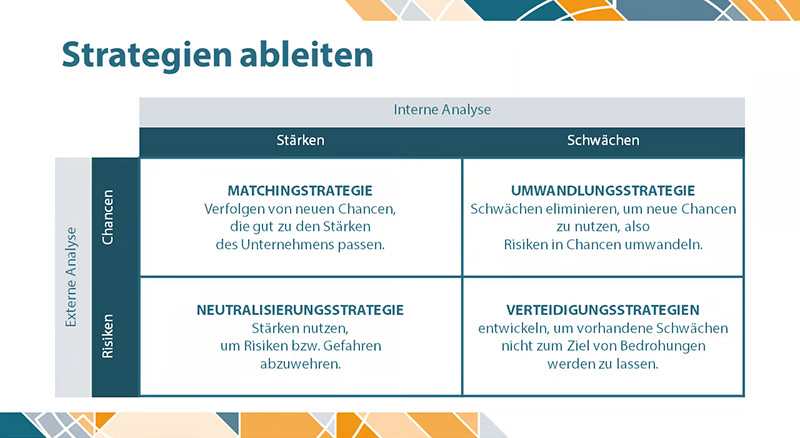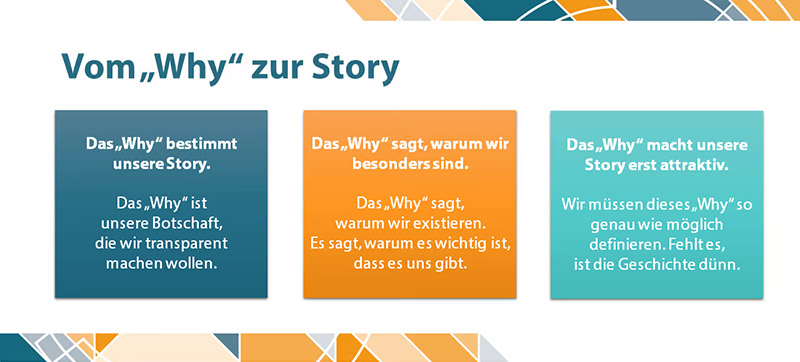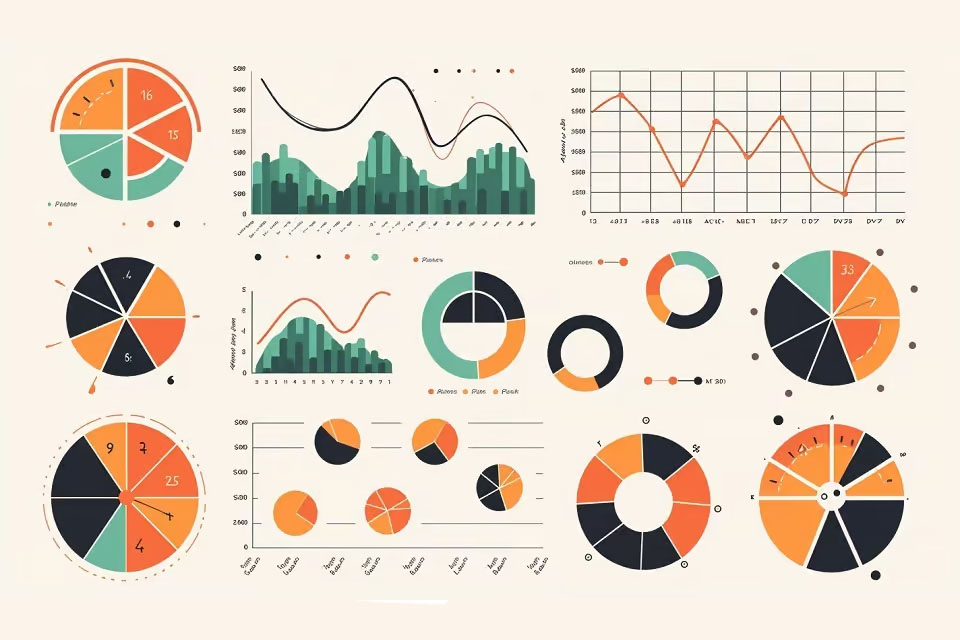The 6 ½ phases of a communication concept
Expand the table of contents
Is your company considered a bit outdated and would you like to create a fresher image?
You invent and develop, are innovative and modern, but hardly anyone recognises it?
Has your company recently been criticised and you want to restore its reputation?
No question: you need a comprehensive communication concept! Not superficial advertising for one of your products, but in-depth trust-based work with the public.
It may sound complex, lengthy and costly, but with the right strategy it’s not rocket science. I will be happy to guide you through the phases in which your communication concept is put into practice.
Phase 1: Analysis – Where do you stand, since when and why?
Every promising communication concept begins with an analysis: Where are you, why are you there, what are others doing instead, how is your environment developing? You don’t need a Harvard Business School catalogue of questions, a CATWOE or PESTLE method1 to do this. All you need to do is ask yourself a few questions:
- What do our customers want from us and why?
- How do our employees manage to fulfil these customer wishes? What do they use and what else do they need?
- What do the clients want and why?
Consider as many different aspects as possible:
- What parameters enable us to do what you do – and which ones hinder us?
- Which economic factors have been important for you in the past, and how could these change in the future?
- What social or cultural trends are influencing your business, what technical developments could help you move forward, what legal hurdles do you need to overcome?
- And above all: Are you perceived by the public as you would like to be – or is the sentiment much more often red than green?
Simple questions that often result in astonishingly profound and far-sighted answers – and goals, directly from the analysis!
Phase 2: Goals – What do you want to achieve by when, how and why?
Do you only get a tired yawn from the target audience of 14 to 29-year-olds? Rejoice, you have identified your first smart goal: 40 per cent more laughter at the end of the year, measured by reactions on TikTok! 😊
Do your critics accuse you of not letting them talk to you? We can talk about this goal too: From now on, you’ll be inviting people to “Ask Me Anything “2 four times a year in the Stadthalle, 20 questions, 20 answers and a flyer with the key points afterwards. Simple problem, simple solution.
Using the SWOT matrix to develop a strategy
- Is the answer one of our strengths?
- Do we need to improve here?
- Is it an opportunity for us or a risk?
If you now link the strengths and weaknesses with the opportunities and risks, a SWOT matrix is created that immediately provides you with four strategies for your communication: strength meets opportunity – great, tell your target groups how you will conquer the world. 😉
With your strength, even a risk can hardly harm you, and an opportunity makes your weakness only half as bad. It’s just stupid when weakness meets risk – then you have to think of a good defence. But at least you now know what to do in all four cases.
Ask your target audience!
He who asks, leads. So go ahead and ask questions that lead you through your company and in several loops through our society, your industry and your market environment to your target groups.
Because this is what a communication concept is all about. Strictly speaking, it is all about these “stakeholders”.
How do individual groups with their individual requirements and perspectives perceive your company? And how can you meet these demands in the medium to long term? What do you need to change or expand? This is the literal core of a communication concept – so work out this core as detailed and carefully as possible.
Phase 3: Strategy – What do you do, how, where and why?
I advise our students who are creating communication concepts suitable for everyday use for real clients to ask themselves Simon Sinek’s famous question “Why”3 – even if many people (maybe you too?) find it annoying by now.
The question is fundamental. Why does the company exist and why do people get up in the morning to work there? What is the purpose, the benefit, the “purpose” that changes our world? Think big, think world-changing! Three examples:
- Why do you make screws and plugs? So that we can hang up the Mona Lisa and show it to the world.
- Why do you sell wheeled suitcases and trolleys? So that we can travel the world and find ourselves in faraway places.
- Why do you produce high-pressure cleaners? So that we can see the Christ in Rio de Janeiro in gleaming white.
It’s about people and their needs. Your company can fulfil these demands – you tell us how, when, where and why with your communication.
So work out your “why”. This “why” is the argumentative core of your communication concept and the leitmotif that first makes people listen, look and think and then makes them realise: “Oh, that’s why they exist, great! Aha, that’s why they do it, brilliant!”
The “why” is your core message. So tweak it for a long time. Until you have removed all the pomposity and trivialities. You already have your core message!
Now it’s almost done. 😉 All you need is a creative central idea, i.e. a nice, tangible story that concretises your often abstract core message and brings it to life in a literary way. The vividness proves that the message works in concrete terms. The comprehensibility shows what the message achieves. It convinces instead of just asserting.
Take the example of BVG:
Let’s take a company where hardly anything works satisfactorily – and everyone knows it, including the company itself: Berliner Verkehrsbetriebe (BVG). Their message, as far as I’m concerned, is that although we are completely underfunded in a completely underfunded city, we keep things running inventively and with passion: with love, rock’n’roll and the typical Berlin touch of extravagance.
But how do you show that? With small, positively crazy campaigns that lovingly take themselves in their arms and embrace the whole of Berlin, no matter who or what you are. “Weil wir Dich lieben,” (Because we love you.) Convincing, isn’t it?
From why to the story
Strictly speaking, a communication campaign is not an advertising campaign. But the means and methods are the same. We exist so that people can use the city (why). But people don’t really like us because nothing works (weakness). But that’s exactly what makes Berlin likeable (opportunity) – the campaign is already designing itself in its basic features. It responds self-deprecatingly and with a big heart to the demands and shows why you simply have to love Berlin.
Phase 4: Measures – How do you reach whom, when and where?
The company slogan even sounds like a direct answer to the question “Why do you even get up in the morning?” and burns itself indelibly into people’s hearts: “Because we love you.”
This provides the argumentative framework for the campaign. You now design customised measures for the many individual target groups that you, as Berliners, know best because you come across them every day. Flyers, posters, performances, reels and cinema advertising, shorts and newspaper adverts and unexpected guerrilla measures. The whole package.
Not just information, but above all meaning
Each individual measure responds to a specific need of a specific group of people. Some want to hold four-colour printed information in their hands, others just want to like it quickly on Instagram. The target groups and their needs for information and entertainment, searching for meaning and expanding knowledge, fun and a sense of belonging4 determine which measures you take, when, where and why.
Give your target group what they need
And this is not trivial, because it means forgetting everything you know from previous campaigns and focussing exclusively on your target groups – each one individually. This is the only reason why communication experts are so (un)fond of modelling personas: To be able to give each individual person their customised response. In the end, we end up with the familiar mix of measures that we had already put together in our heads – but this time strategically underpinned and justified. That is the decisive difference.
Phase 5: Distribution – Who gets what when and where?
How do the measures get to those who demand them? Distribution is also an important part of a good communication campaign – by when does what need to be commissioned, briefed, designed and coordinated, produced and released and in what quantity so that you can upload it to a platform or get it from the printers in good time? And what does it all cost?
You can utilise your management and Excel skills here, but it’s better to use project management software or Scompler5 or Sprinklr6 for your campaign planning. 😉
Phase 6: Evaluation – What performed when, how, where and why?
Your software should also be able to measure. At least the important metrics and KPIs such as reach and interactions, click or open rate. You need to be able to evaluate the success or failure of your measures individually. This is of course easier online than analogue, but even there it is important to find out whether your communication efforts are actually getting through.
Because: You can draw conclusions from this for the next phase of your communication campaign. What went well, what didn’t, and what could have been the reason? You should analyse this.
Phase 6 ½ in the communication concept
Analyse? So starting all over again with the communication concept?
No, of course not from scratch. But rather: from the beginning again. Again from the beginning with adapted goals and optimised measures. A campaign, once started, never stops. Not in these times of the long tail and the digital “Internet forgets nothing”. Campaigns in our times may have a beginning, starting on a specific kick-off day – but they no longer end like traditional campaigns, where the posters were rolled up and the newspapers with the adverts ended up as lettuce wrappers.
On the web, campaigns can be restarted, optimised, adapted and turned around again and again. A huge advantage compared to the past. Use this opportunity! Optimise your campaign with the insights you can gain from monitoring and evaluation loops. And start again. This is sustainability in communication and the prerequisite for a successful communication concept.
Extra bonus
Here you will find 3 additional questions on communication concepts answered by Harald Ille (please click the plus buttons):
From what size of company does it make sense to deal with communication concepts?
Harald Ille: In principle, there is no “minimum size” to deal with communication concepts; freelancers or small craft businesses can also benefit from them if they want to present themselves to the public. A communication concept helps in different “degrees of maturity” and depths of detail and is not just an investment for large corporations with exorbitant budgets.
Smaller companies with a rarely visited LinkedIn page, a bit of Instagram and a few adverts in the local newspaper can get much more out of their communication measures, save money and nerves and become a little better known. Especially if the product needs explaining and the cash register isn’t ringing quite so loudly at the moment. 😊
A communication concept is not about product advertising, but about building trust. It’s about making potential customers aware of the company’s expertise:
- “I’m the most trustworthy plumber in the county!”
- “My style consultation will make you more than just a haircut!”
- “I know all the methods and will find the right solution for you!”
Especially for small companies, a gentle communication concept can sometimes be more promising than two more roaring four-colour ads in the local gazette.
What unconventional methods could companies use to achieve their communication goals and surprise their target groups at the same time?
Harald Ille: Unconventional methods are usually the result of intensive conventional engagement with the topic, a lot of brainpower, research, deep dives and the tireless testing of the limits of conventional methods. And, of course, the desire to do things better, differently, in a new way – Blue Ocean instead of Red Ocean, as economics would say.
I have had very good experiences with turning conventional ideas round by 180 degrees. What if the subject became the object and the object became the subject? If we were not the sellers but the buyers ourselves?
There are many compelling unconventional campaigns that subvert our expectations like a good joke. By doing exactly the opposite of what we would do in everyday life. Or they take an opposite position to the logical, “natural” position for us.
How do you do that? You take an associative approach and start by writing down everything (and I mean everything!) that comes to mind about the company, products, buyer groups, touchpoints, etc., and what other associations this evokes. With a bit of patience, lots of metaplan boards filled with ideas and a bit of courage, hopefully two or three promising ideas will tumble out.
The more unexpected the idea, the more surprised the target group and the deeper and more convincing the impression on them.
How can organisations ensure that their communication efforts are not only informative, but also connect with their audience?
Harald Ille: By planting the information not only in the head, but also in the proverbial heart of the audience.
We all forget far too often that the actual decision to buy a product or accept an argument, for example, is not based on our reasoning but on our feelings. Does it feel good and right? Then we as an audience are much more willing to engage with this connection to the company. And by “heart” I don’t mean whiny sentimentality, but a real understanding of the neurobiological processes in our brain – because that’s where our fears and joys originate, below our reasoning. Many of us long for security, trust and the gratitude of finally being understood.
If the company information also conveys these emotional messages, the connection to the audience can be established much more quickly and become more sustainable than with information that is reduced to the bare essentials and therefore comes across as cold and dismissive.
So it’s better to give one more vivid explanation than one too few. Better one more vivid example than one too few. Prove to the audience that the company answers their questions, allays their fears, fulfils their need for explanation and understanding – in an intellectual, objective and motherly-hearted way. This provides security – and a basic feeling of trust.
[1] CATWOE analyses six factors that are essential for the success of a project. The PESTLE method is an approach that companies and public authorities can use to track six areas in their environment and their development and change.
[2] Example fo Ask me anything.
[3] Simon Sinek: Start with Why
[4] Der Fisch im Radar: So kommt die Strategie in den Content
[5] Scompler
[6] Sprinklr
Do you want to convince your customers and not persuade them? Then take a look at Harald Ille’s beautiful website.
If you like the article or want to discuss it, feel free to share it with your network.
Harald Ille has published more posts in the t2informatik Blog:

Harald Ille
Harald Ille is an experienced journalist and university lecturer in public relations (PR). He has worked in PR and corporate communications for local authorities, hospitals and corporations for almost 25 years. As a self-employed “digital enthusiast”, he is passionate about the life-changing opportunities that digital technologies offer us.
In the t2informatik Blog, we publish articles for people in organisations. For these people, we develop and modernise software. Pragmatic. ✔️ Personal. ✔️ Professional. ✔️ Click here to find out more.




